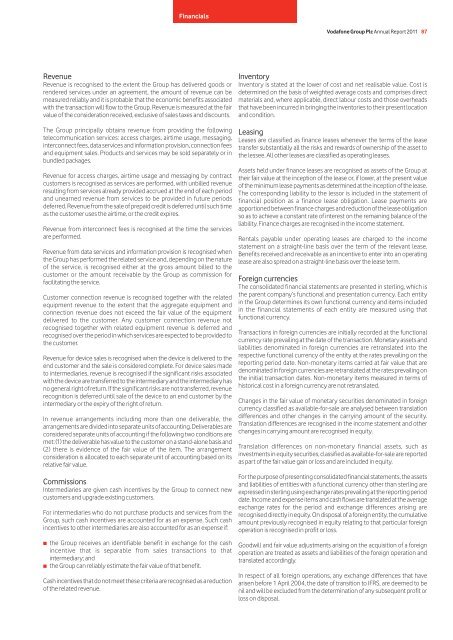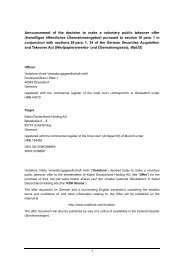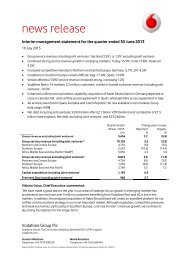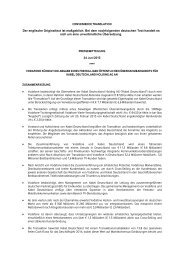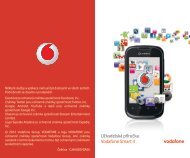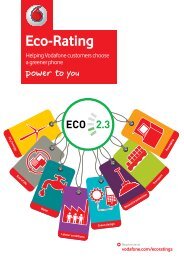Download the report - Vodafone
Download the report - Vodafone
Download the report - Vodafone
Create successful ePaper yourself
Turn your PDF publications into a flip-book with our unique Google optimized e-Paper software.
Financials<br />
Revenue<br />
Revenue is recognised to <strong>the</strong> extent <strong>the</strong> Group has delivered goods or<br />
rendered services under an agreement, <strong>the</strong> amount of revenue can be<br />
measured reliably and it is probable that <strong>the</strong> economic benefits associated<br />
with <strong>the</strong> transaction will flow to <strong>the</strong> Group. Revenue is measured at <strong>the</strong> fair<br />
value of <strong>the</strong> consideration received, exclusive of sales taxes and discounts.<br />
The Group principally obtains revenue from providing <strong>the</strong> following<br />
telecommunication services: access charges, airtime usage, messaging,<br />
interconnect fees, data services and information provision, connection fees<br />
and equipment sales. Products and services may be sold separately or in<br />
bundled packages.<br />
Revenue for access charges, airtime usage and messaging by contract<br />
customers is recognised as services are performed, with unbilled revenue<br />
resulting from services already provided accrued at <strong>the</strong> end of each period<br />
and unearned revenue from services to be provided in future periods<br />
deferred. Revenue from <strong>the</strong> sale of prepaid credit is deferred until such time<br />
as <strong>the</strong> customer uses <strong>the</strong> airtime, or <strong>the</strong> credit expires.<br />
Revenue from interconnect fees is recognised at <strong>the</strong> time <strong>the</strong> services<br />
are performed.<br />
Revenue from data services and information provision is recognised when<br />
<strong>the</strong> Group has performed <strong>the</strong> related service and, depending on <strong>the</strong> nature<br />
of <strong>the</strong> service, is recognised ei<strong>the</strong>r at <strong>the</strong> gross amount billed to <strong>the</strong><br />
customer or <strong>the</strong> amount receivable by <strong>the</strong> Group as commission for<br />
facilitating <strong>the</strong> service.<br />
Customer connection revenue is recognised toge<strong>the</strong>r with <strong>the</strong> related<br />
equipment revenue to <strong>the</strong> extent that <strong>the</strong> aggregate equipment and<br />
connection revenue does not exceed <strong>the</strong> fair value of <strong>the</strong> equipment<br />
delivered to <strong>the</strong> customer. Any customer connection revenue not<br />
recognised toge<strong>the</strong>r with related equipment revenue is deferred and<br />
recognised over <strong>the</strong> period in which services are expected to be provided to<br />
<strong>the</strong> customer.<br />
Revenue for device sales is recognised when <strong>the</strong> device is delivered to <strong>the</strong><br />
end customer and <strong>the</strong> sale is considered complete. For device sales made<br />
to intermediaries, revenue is recognised if <strong>the</strong> significant risks associated<br />
with <strong>the</strong> device are transferred to <strong>the</strong> intermediary and <strong>the</strong> intermediary has<br />
no general right of return. If <strong>the</strong> significant risks are not transferred, revenue<br />
recognition is deferred until sale of <strong>the</strong> device to an end customer by <strong>the</strong><br />
intermediary or <strong>the</strong> expiry of <strong>the</strong> right of return.<br />
In revenue arrangements including more than one deliverable, <strong>the</strong><br />
arrangements are divided into separate units of accounting. Deliverables are<br />
considered separate units of accounting if <strong>the</strong> following two conditions are<br />
met: (1) <strong>the</strong> deliverable has value to <strong>the</strong> customer on a stand-alone basis and<br />
(2) <strong>the</strong>re is evidence of <strong>the</strong> fair value of <strong>the</strong> item. The arrangement<br />
consideration is allocated to each separate unit of accounting based on its<br />
relative fair value.<br />
Commissions<br />
Intermediaries are given cash incentives by <strong>the</strong> Group to connect new<br />
customers and upgrade existing customers.<br />
For intermediaries who do not purchase products and services from <strong>the</strong><br />
Group, such cash incentives are accounted for as an expense. Such cash<br />
incentives to o<strong>the</strong>r intermediaries are also accounted for as an expense if:<br />
■ <strong>the</strong> Group receives an identifiable benefit in exchange for <strong>the</strong> cash<br />
incentive that is separable from sales transactions to that<br />
intermediary; and<br />
■ <strong>the</strong> Group can reliably estimate <strong>the</strong> fair value of that benefit.<br />
Cash incentives that do not meet <strong>the</strong>se criteria are recognised as a reduction<br />
of <strong>the</strong> related revenue.<br />
<strong>Vodafone</strong> Group Plc Annual Report 2011 87<br />
Inventory<br />
Inventory is stated at <strong>the</strong> lower of cost and net realisable value. Cost is<br />
determined on <strong>the</strong> basis of weighted average costs and comprises direct<br />
materials and, where applicable, direct labour costs and those overheads<br />
that have been incurred in bringing <strong>the</strong> inventories to <strong>the</strong>ir present location<br />
and condition.<br />
Leasing<br />
Leases are classified as finance leases whenever <strong>the</strong> terms of <strong>the</strong> lease<br />
transfer substantially all <strong>the</strong> risks and rewards of ownership of <strong>the</strong> asset to<br />
<strong>the</strong> lessee. All o<strong>the</strong>r leases are classified as operating leases.<br />
Assets held under finance leases are recognised as assets of <strong>the</strong> Group at<br />
<strong>the</strong>ir fair value at <strong>the</strong> inception of <strong>the</strong> lease or, if lower, at <strong>the</strong> present value<br />
of <strong>the</strong> minimum lease payments as determined at <strong>the</strong> inception of <strong>the</strong> lease.<br />
The corresponding liability to <strong>the</strong> lessor is included in <strong>the</strong> statement of<br />
financial position as a finance lease obligation. Lease payments are<br />
apportioned between finance charges and reduction of <strong>the</strong> lease obligation<br />
so as to achieve a constant rate of interest on <strong>the</strong> remaining balance of <strong>the</strong><br />
liability. Finance charges are recognised in <strong>the</strong> income statement.<br />
Rentals payable under operating leases are charged to <strong>the</strong> income<br />
statement on a straight-line basis over <strong>the</strong> term of <strong>the</strong> relevant lease.<br />
Benefits received and receivable as an incentive to enter into an operating<br />
lease are also spread on a straight-line basis over <strong>the</strong> lease term.<br />
Foreign currencies<br />
The consolidated financial statements are presented in sterling, which is<br />
<strong>the</strong> parent company’s functional and presentation currency. Each entity<br />
in <strong>the</strong> Group determines its own functional currency and items included<br />
in <strong>the</strong> financial statements of each entity are measured using that<br />
functional currency.<br />
Transactions in foreign currencies are initially recorded at <strong>the</strong> functional<br />
currency rate prevailing at <strong>the</strong> date of <strong>the</strong> transaction. Monetary assets and<br />
liabilities denominated in foreign currencies are retranslated into <strong>the</strong><br />
respective functional currency of <strong>the</strong> entity at <strong>the</strong> rates prevailing on <strong>the</strong><br />
<strong>report</strong>ing period date. Non-monetary items carried at fair value that are<br />
denominated in foreign currencies are retranslated at <strong>the</strong> rates prevailing on<br />
<strong>the</strong> initial transaction dates. Non-monetary items measured in terms of<br />
historical cost in a foreign currency are not retranslated.<br />
Changes in <strong>the</strong> fair value of monetary securities denominated in foreign<br />
currency classified as available-for-sale are analysed between translation<br />
differences and o<strong>the</strong>r changes in <strong>the</strong> carrying amount of <strong>the</strong> security.<br />
Translation differences are recognised in <strong>the</strong> income statement and o<strong>the</strong>r<br />
changes in carrying amount are recognised in equity.<br />
Translation differences on non-monetary financial assets, such as<br />
investments in equity securities, classified as available-for-sale are <strong>report</strong>ed<br />
as part of <strong>the</strong> fair value gain or loss and are included in equity.<br />
For <strong>the</strong> purpose of presenting consolidated financial statements, <strong>the</strong> assets<br />
and liabilities of entities with a functional currency o<strong>the</strong>r than sterling are<br />
expressed in sterling using exchange rates prevailing at <strong>the</strong> <strong>report</strong>ing period<br />
date. Income and expense items and cash flows are translated at <strong>the</strong> average<br />
exchange rates for <strong>the</strong> period and exchange differences arising are<br />
recognised directly in equity. On disposal of a foreign entity, <strong>the</strong> cumulative<br />
amount previously recognised in equity relating to that particular foreign<br />
operation is recognised in profit or loss.<br />
Goodwill and fair value adjustments arising on <strong>the</strong> acquisition of a foreign<br />
operation are treated as assets and liabilities of <strong>the</strong> foreign operation and<br />
translated accordingly.<br />
In respect of all foreign operations, any exchange differences that have<br />
arisen before 1 April 2004, <strong>the</strong> date of transition to IFRS, are deemed to be<br />
nil and will be excluded from <strong>the</strong> determination of any subsequent profit or<br />
loss on disposal.


